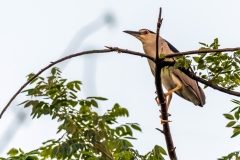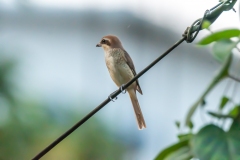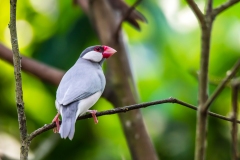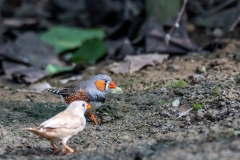In this post, I show some photographs of Asian Openbill, Indian Cormorants, Black-crowned night heron shot in Duttabagan (Kolkata), Asian Openbills, Hairy crested Drongo, and birds conserved in Raiganj Bird Sanctuary. I need to introduce alien terms to my readers, especially because I got this as feedback. So here I go…
Duttabagan is a place in north Kolkata. My father’s home is in Dum Dum Park (DDP). The nearest metro station is Belgachia. On the way from DDP to Belgachia, is Duttabagan.
Raiganj Bird Sanctuary is in Raiganj. Raiganj is in North Dinajpur, in the Indian slice of Bengal. I am not sure what more to write here. If you need to know how to go there, you could just Google.
“Mamar Bari“ is the home of Mama; Mama is the brother of my mother. So basically, where my uncle lives. In Bengali homes, Mamar Bari is a place where children get pampered, whether they are 3 or 33. I have 5 direct Mamas, and two prominent Mamar Baris; one in Gangarampur (South Dinajpur) and one in Raiganj-Durgapur (North Dinajpur).
“Pujo” is Durga Puja; that’s the biggest festival in Bengal. People invoke Goddess Durga and worship her. It’s technically a 4-day festival but people often make it a month-long festival, because why not?
With the terminology straightened, let’s start with the blog post!
Duttabagan (near Belgachia, Kolkata)
While going to the nearest metro station, the auto stops at multiple signals. At the Duttabagan crossing, I noticed Open-billed storks flying all over the place. I got down and inquired the local people about the whereabouts of the birds. I got to know that there’s a king and a palace and that the palace has a lake. More interestingly there is a patch of land, now a fenced jungle with no entry point, under the Indian Railways.
It all made sense because why not? There were landlords who were called “Raja” (king) and maybe Indian Railways have land because just beside that place is the Belgachia Metro station, which is under the Central Government, Ministry of Railways.
The jungle is dense with no legal entry points, and almost every tree has several nests of Indian Cormorants and Asian Openbill. They live with their families, eat, shit, build larger homes, make noise, etc.
What would you find there? A lot of Open-billed Storks (Asian Openbill) with their nests, Indian Cormorants (with their nests), Black-crowned Night Herons (with families), and the generic birds like Black Kites, pied Myna, red-vented bulbul, etc.
Mamar Bari in Gangarampur
One morning my mother, beaming with excitement asked me whether I would go to Mamar Bari during Pujo. I said yes, especially because I haven’t been there for 22 years. The idea of spending some time with my cousins was great, and I thought I could also photograph some birds there because why not?
While almost everything about and around my Mamar Bari changed, there still remains the pond that I feared as a kid. I was told that there are snakes and I have always had this irrational fear of snakes. On the pond are white-breasted waterhens with family, bronze-winged Jacana with family, and a very singular brown shrike that flies, hops, and looks here and there. Of course, there are other birds like chickens, generic random ducks, an extraordinary amount of pied mynas, and crows.
Raiganj Bird Sanctuary
On the train to Gangarampur, I met a couple of interesting people. One of them is Dhiman. When he got to know that I want to photograph birds, he suggested that I go to Kulik forest. Kulik forest is in Raiganj, and it hosts the Raiganj Bird Sanctuary. It is presumed to be the second largest bird sanctuary in Asia. And lo, here I am in Raiganj writing this blog post.
I had no idea about this bird sanctuary, but this place exists for a long time. According to a 2011 report, birds refused to land here, and that caused concern. But as recently as 2022, a report by Uttara di mentions how Asian Openbills can be observed in this sanctuary. The official records mention that as many as 71300 Asian Openbill storks were in the Sanctuary last year. This year they expect more birds to come. You can easily spot Asian Openbill, Indian Cormorants, Egrets, and night herons. If you are a non-birder, please check this vlog for their coverage. While you walk the path, you would see baby Asian Openbills walking around, mostly because they can not fly and they do not know human beings are dangerous. In the sanctuary, there are watch towers that oversee the turtle pond and are erected right next to the big trees. You can see the birds if not photograph them. Photographing them is a little difficult; birds can easily disappear in the midst of the leaves and branches. There is a section for bats. I do not know much about bats and I am a little scared. Birds are nice and safe :3
I could only spend 1.5 hours inside the sanctuary and it was amazing. If you are an avid birder, you might want to spend some more time in the sanctuary and also the lodge on the opposite side of the sanctuary.
Since I had an over-exposure to Asian Openbill, Cormorants, and night herons in Duttabagan, I decided to not photograph much. The Raiganj bird sanctuary also has a conservation center for birds and fishes. I had no clue about the aviary because I have never been to one. There were two doors, both unmanned, with no cameras and no locks. I opened them and entered the space for birds. The birds were alarmed. I stood there like a statue for a couple of moments and then sat down like a nice boy. After around 4-5 mins the birds understood that I am not there to harm them. They continued with their daily life – jumping, walking, flying here and there, attracting females and failing at that, eating, shitting, flying to another place, etc. After I gained their trust, I photographed them. After some time, I left.
In case you wonder because some did, why are these birds kept here? You can have your own theory. But since I did not find a clear convincing official reason, my claim would be that the police intercepted illegal wildlife racketing and the birds are sent here. But I have no evidence to substantiate my claim. Whatever the reason, this could be a fantastic entry point for young children and the otherwise uninitiated to the world of birds and we could talk about conservation!
Umm, how should I end this blog post? Maybe with a few pointers:
- Carry your birding lens everywhere. Maybe you do not have an ecosystem that supports you chasing birds. If you carry your lens with you, maybe you may come across something interesting.
- Your neighborhood might be an interesting place. I have never seen social media posts about people birding in Duttabagan!
- I need to explore more of my state! Do you know around 900 species of birds can be seen in West Bengal?
- Do visit the Raiganj Bird Sanctuary! It might seem very obvious and on the face, but this is a very well-maintained bird sanctuary and you might just have a good time!
That’s all for now, Regards,



































